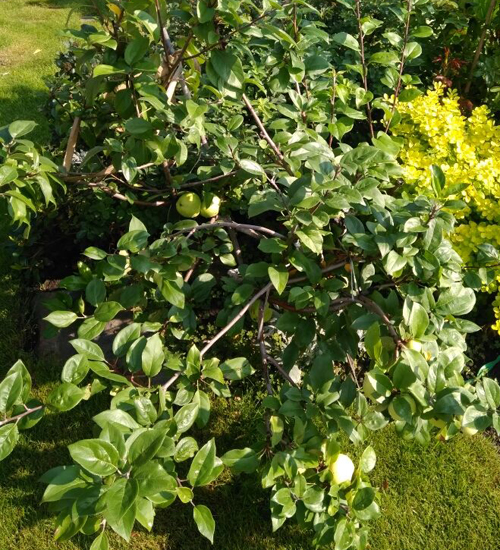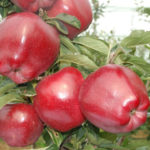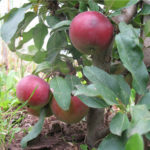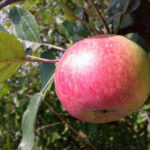Apple variety Crumb (bush)
Gardening today cannot be imagined without dwarf plants. Their advantages are obvious to everyone: simple care (associated primarily with the convenience of pruning, spraying, harvesting), early entry into the fruiting phase, high yield per unit area. On the backyard and garden plots, a huge advantage of low-growing trees is the ability to place dozens of varieties and types of fruit crops in a very limited area, which, of course, could not be done with trees of standard dimensions.
Speaking of dwarf apple varieties, the imagination draws, first of all, reduced copies of ordinary trees, or column-shaped trees that are very fashionable today. However, breeding science sometimes turns out to be much more unpredictable than our imagination, never ceasing to amaze us with the quirkiness of its creations. One of these unusual varieties is a bush apple tree called Tiny. In its adult form, it is a compact shrub with thin hanging branches, no more than a meter high, but at the same time generously strewn with medium-sized white-green fruits. Branches often come into contact with the ground and take root in these places, forming shoots.

Initially, the variety was bred at Michurinsky State Agrarian University, located in the Tambov region, from crossing Moscow pears and stock M8. The form was presented as a new dwarf intercalated rootstock G-134, but over time in nurseries it was noticed that it grows in a compact bush and at the same time bears fruit abundantly. Seeing such a picture, one of the private breeders was not at a loss, starting to sell seedlings as a regular variety, calling it the name of the Little One, which is widely known today.
The leaves of our heroine are medium-sized, shiny, leathery, gray-green in color. Plants begin to bear fruit in the third year, increasing the yield for several more seasons until they reach maximum productivity. Flowering times depend on the growing region, but usually fall in the month of May. The color of the flowers is light pink. The species does not need to be planted nearby pollinators, as it is self-fertile. The frequency of fruiting with good care is not observed, the apple tree annually pleases its owners with abundant harvests. From a seemingly miniature bush, up to three buckets of medium-sized apples weighing about 100 grams are removed. Fruit ripening occurs in late August - early September, and according to this indicator, the variety belongs to the group of autumn varieties. The shape of our heroine's apples is rounded with noticeable ribbing. The skin is thin, the pulp is juicy, coarse-grained, snow-white in color with an elegant varietal aroma and a pleasant sweet-sour taste.
The harvested fruits are not suitable for long-term storage, under normal conditions their keeping quality is about two weeks, and in cool rooms or refrigerated chambers it can reach a month. The harvest is universal in the directions of use. It can be equally well consumed fresh or processed into juices, compotes, preserves, marmalades and jams. Dried fruits and crumbs are excellent in quality. The palatability of fresh apple fruits is highly rated.
In economic terms, it is necessary to note the good resistance of trees to scab, but information about their winter hardiness is extremely contradictory. Some gardeners argue that planted trees freeze out even in not the coldest winters, while others are trying to challenge this opinion, characterizing the variety as quite frost-resistant. The truth seems to lie somewhere in between. So, the sufficient resistance to frost of the aboveground part of the Krokha bushes is beyond doubt, but the "weak link" is the surface root system, which does not withstand any significant drop in temperatures, especially in snowless winters.This explains the fact that in some owners the plants covered with snow endure severe cold weather, while in others, in snowless regions, the plants die during relatively low frosts.
Features of agricultural technology
The approach to the cultivation of our heroine for the most part differs little from the events carried out on other low-growing apple varieties. Planting is most favorable on gentle slopes of warm exposures, or on flat areas. Places with low relief, such as hollows and gullies, should not be used for cultivation. Here, groundwater is often located close to the soil surface, which has a depressing effect on fruit crops, and there is also stagnation of cold air, which carries many problems. So, the lack of normal air exchange in the garden leads in winter to freezing of trees, and in spring to frequent damage to flowers by recurrent frosts. For the same reason, vegetative plants are more likely to suffer from fungal diseases.
The approximate layout of the Crumbs on the site is 1.5 × 1.5 m. The planting holes are dug out large enough to freely place the root system of the seedling in it. It is well seasoned with mineral and organic fertilizers to ensure active growth of vegetative mass in the first years. The planted trees are watered abundantly with water, after which the soil surface is mulched. The planting of the apple tree itself can be carried out both in the spring, without waiting for the buds to bloom, and in the fall after the leaf fall.
Before entering fruiting, the variety must undergo an annual formative pruning. Its main goal is to create a volumetric crown correctly located in space, which will become the basis for future high yields. Pruning fruit-bearing trees, in addition to the clear goal of obtaining the maximum number of good quality fruit, should also help maintain vegetative activity. If the annual growth becomes very weak, the plants need anti-aging pruning.
The land under the apple trees, depending on the moisture content of the site, is kept either under the so-called "black fallow", or sown with perennial grasses, which are periodically mowed, leaving the green mass in place as mulch. The first method involves the complete removal of vegetation in the garden with the help of regular weeding, loosening the soil or cultivating it. This option is better suited for non-irrigated areas in areas of insufficient moisture. If there is enough rain or irrigation moisture, then the second, the so-called "sod-humus" system will be ideal. It not only simplifies the maintenance of the garden, but also contributes to the accumulation of humus in the soil, which in the future will certainly affect the yield of fruit trees.
During the growing season, the main activities in the garden are pest and disease control, as well as feeding and watering. As already mentioned, the Crumb is quite resistant to the main disease of apple trees - scab, and therefore only needs preventive protection from it. With regard to less harmful fungal pathogens, cultivars are processed upon the fact of their appearance with drugs of systemic action, with the obligatory adherence to instructions and adherence to waiting times. Against the flower beetle, leaf rollers, moths and aphids, spraying with an insecticide is carried out before flowering, repeating when the ovary appears, but already mainly against the moth.
Top dressing is carried out with moderate doses of mineral fertilizers, using nitrogen fertilizers in early spring, and later nitrogen-phosphorus fertilizers, or complex fertilizers. It is very convenient to combine them with watering, dissolving the required amount of fertilizer in water and introducing them into the soil ready for assimilation.Irrigation is especially needed for gardens located in the southern arid areas, where the superficial root system of Krohi is not able to extract life-giving moisture from deep soil horizons. An excellent effect is also given by late-autumn water-charging irrigation, as a result of which the soil and plant tissues are saturated with moisture, as a result of which the soil does not freeze so much, and the trees improve frost resistance.
After the foliage has fallen, it is removed from the site or buried in the ground, and the apple tree trunks are tied with an improvised insulating material to improve frost resistance. In late autumn, spraying the branches with a 5% solution of ferrous sulfate in order to combat parasitic moss and lichens will also not be superfluous.








